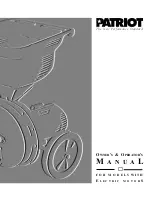
20
7 - START-UP
Unit start-up is done by the electronic control described in the
manual “30SZ/SZV Pro-Dialog Plus control”, and must always
be carried out under the supervision of a qualified air condi-
tioning engineer.
7.1 - Necessary checks/precautions before start-up
-
Ensure that all electrical connections are properly
tightened.
-
Ensure that the unit is level and well-supported.
-
Check that the hydraulic circuit has sufficient water flow
and that the pipe connections correspond to the installation
diagram.
-
Ensure that there are no water losses. Check the correct
operation of the valves installed.
-
All the panels should be fitted and firmly secured with the
corresponding screws.
-
Make sure that there is sufficient space for servicing and
maintenance purposes.
-
Ensure that there are no refrigerant leaks.
-
Confirm that the electrical power source agrees with the
unit nameplate rating, wiring diagram and other documen-
tation for the unit.
-
Ensure that the power supply corresponds to the applicable
standards.
-
Make sure that compressors float freely on the mounting
springs.
WARNING: The compressors are mounted on vibration
isolators. Do not loosen or remove the support mounting bolts.
7.2 - Initial checks
With the unit in operation, ensure that the high and low
pressure values shown on the display are within the normal
limits. It is advisable to simulate unit shutdown due to high
pressure, in order to make sure that the pressurestat works
properly. To do so, proceed as follows:
-
High pressure shutdown: Shut off the water inlet to the
outdoor heat exchanger. The unit should stop at a pressure
of 2700 kPa.
The high pressure switch has manual reset.
Check that the motor and compressor power consumption is
approximately the same as shown on the unit nameplate. These
values are also shown in the Electrical Data table.
7.3 - Refrigerant system description
The refrigerant circuit incorporates the following principal
elements:
-
Plate heat exchanger, made of brazed steel. The special
shape of these plates makes them very efficient.
-
Copper refrigerant lines
-
Expansion valve
-
Compressors (hermetic or semi-hermetic)
-
Filter drier
-
Schrader valves
-
Safety elements: high pressurestats, fusible plugs
-
High-pressure, low-pressure and oil pressure sensor
(30SZV 018-036)
-
Liquid solenoid valve (30SZV)
-
All units, except condenserless units, include the R-407C
refrigerant charge necessary for correct operation.
7.4 - Compressor replacement
30SZ/SZV 004-011
As the compressors are hermetic, when an internal fault occurs,
the compressor must be replaced. This must be done as detailed
below:
-
Disconnect the unit from the electrical supply.
-
Remove the panels.
-
Remove the gas from the refrigerant circuit using recovery
equipment to avoid contaminating the atmosphere.
-
Electrically disconnect the compressor.
-
Unbraze or unscrew the suction and discharge lines,
taking care not to damage the rest of the components.
-
Remove the fastenings.
-
Replace the compressor, ensuring that it contains
sufficient oil.
-
Braze or screw in the lines (brazing in a neutral
atmosphere).
-
Connect the compressor according to the wiring diagram.
-
Pump down the compressor.
-
Fill in the refrigerant charge indicated on the nameplate.
30SZ/SZV 018-036
These units have semi-hermetic compressors, and their internal
components can be repaired, if it not necessary to replace the
compressor.
7.5 - Description of unit protection devices
The unit includes the following protection devices:
-
Internal or external compressor protection (depending on
the model)
-
Main switch
-
Anti-short-cycle protection
-
Thermomagnetic compressor switch
-
Thermomagnetic control switch
-
Anti-freeze protection
-
Evaporator leaving water limit thermostat
-
Temperature sensor fault detector
-
Oil pressure safety switch (30SZV 018-036)
-
High pressurestat: This protects the unit against excessive
condensing pressure. The high pressurestat has factory-
fixed non-adjustable settings. To check, see section
“Initial Checks”.
-
Low pressure safety switch.





































